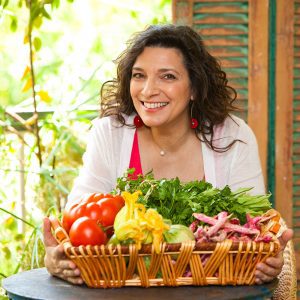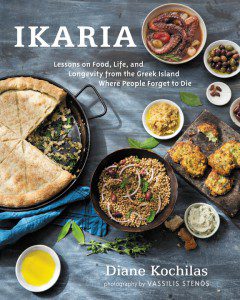Diane Kochilas’ publicist sent me a copy of Ikaria: Lessons on Food, Life, and Longevity from the Island Where People  Forget to Die, her cookbook just published last month. I knew of Diane — an authority on Greek cuisine — but had never met her. I knew that her Glorious Foods of Greece had won the prestigious IACP Jane Grigson Award for Excellence in Research, and that she’s the consulting chef at Molyvos, a NYC Greek restaurant near Carnegie Hall that I’ve dined at before I began reviewing.
Forget to Die, her cookbook just published last month. I knew of Diane — an authority on Greek cuisine — but had never met her. I knew that her Glorious Foods of Greece had won the prestigious IACP Jane Grigson Award for Excellence in Research, and that she’s the consulting chef at Molyvos, a NYC Greek restaurant near Carnegie Hall that I’ve dined at before I began reviewing.
I learned recently — after reaching out to her to be our Guest Foodie — that she has the Glorious Greek Kitchen, a summer cooking school on the island of Ikaria in the northeastern Aegean. I’d love to return to the islands one summer to experience her teachings. In the meantime, I’ll just enjoy reading about her healthy ways with food in her new book. The book contains simple good food, with over 100 recipes, including her pan-roasted potatoes and zucchini.
What follows are Diane’s responses to my questions. Many of the dishes she refers to in her answers are from her Ikaria cookbook.
– bonnie
Which food product or gadget would you never give up? That’s a tough one. As for ingredients, I’d have to say olive oil. It’s just about the one constant in almost everything I cook, savory and sweet. It’s the Greek gene! Can’t live without it. (It goes without saying that I am talking about Greek olive oil!)
As for gadgets, I am a classicist. I can’t live without my chef’s knife, a paring knife and my immersion blender.
What do you like to serve when you entertain? I love to entertain. I have an open kitchen and an Ikarian’s sense of time, so  when I invite people for dinner they often find me still cooking…that means I always have to provide a snack or two for them to nibble on over drinks, usually wine, while they lean over the counter to see what’s in the pots. I might make an embellished hummus, with red peppers, feta, fresh herbs; a whipped spicy feta dip or an Ikarian kopanisti; little canapes with thin slices of botargo, black pepper and lemon; or I might go totally traditional and serve chilled tsipouro (Greek grappa — which is almost always local from Ikaria in our home), with home-dried fruits such as pears, apples and figs. This is very traditional on the island and our Athenian friends are always surprised by how well the dried fruits pair with the alcohol.
when I invite people for dinner they often find me still cooking…that means I always have to provide a snack or two for them to nibble on over drinks, usually wine, while they lean over the counter to see what’s in the pots. I might make an embellished hummus, with red peppers, feta, fresh herbs; a whipped spicy feta dip or an Ikarian kopanisti; little canapes with thin slices of botargo, black pepper and lemon; or I might go totally traditional and serve chilled tsipouro (Greek grappa — which is almost always local from Ikaria in our home), with home-dried fruits such as pears, apples and figs. This is very traditional on the island and our Athenian friends are always surprised by how well the dried fruits pair with the alcohol.
I almost always serve soup at dinner parties. Greeks don’t have a huge soup tradition — it’s a warm country; we have lots of salads! — but soup is probably my favorite food because I can think color-garnish-drizzle of something. One of my favorite soups and one people are surprised by because it’s made with a very pedestrian ingredient, is cauliflower veloute, which I top with shaved botargo or Greek taramosalata (fish roe dip) and early harvest Greek olive oil. I make a chestnut-ouzo soup around this time of the year that is a winner, too.
Greeks don’t necessarily eat in courses so what follows is usually an array of food that is placed on the table at once for all to share. The last few dinner parties I’ve had have included homemade pasta — one stuffed with Greek goat’s cheese and topped with a loose fig-olive compote; the other stuffed with octopus and topped with slow-cooked whole small onions, sweet wine and tomatoes. (We did this at Molyvos for a while, too.)
I love octopus and might make it the Ikarian way, braised with wine; I might serve another local dish from the island — one that also throws people off because they aren’t familiar with the combination of ingredients: greens sautèed with roe. It’s a very old “meze” from Ikaria and it could stand on its own as a high-end plate any day of the year.
Some recent hits at dinner parties have also been: the rectangular greens pies (pitarakia); beet keftedes with lemon-zest tzatziki; whole batter-cooked eggplant with fresh tomato sauce, an amazingly simple dish from Ikaria, one of my favorites.
I always do dessert. Sometimes I go classic American, i.e. an apple pie with my own pastry. Most of the time I make international desserts with a Greek twist (panacota with Greek yogurt and Chios Mastiha or with Rose Petal Jam., for example). This Saturday we have friends coming over and I am working on a Greek floating island, something I want to do at Molyvos, too.
Describe your “last meal?” Tough one. Probably not a meal. Maybe the most perfect slice of watermelon, or a Greek tomato circa 1970, with my aunt’s fresh goat’s milk cheese, really fresh olive oil, Greek sea salt and sourdough bread. Greek umami.
What food is your secret guilty pleasure? Gooey-ooey grilled cheese by far! And bananas with merenda (a chocolate hazelnut spread). And peanut butter and jelly on soft white bread, the best of 1960s junk food and a treat I indulge in on my darkest-I-miss-NY-days, which I still get 22 years after leaving the city! And New York pizza. They’re all tied to nostalgia and childhood…
What is your go-to neighborhood restaurant? Go-to in NY is a little Thai place that serves amazing food (even the NYT likes it), up the street from the house I grew up in in Queens. It’s called Ayada. In Greece, my favorite neighborhood restaurant is a down-and-dirty souvlaki joint in the heart of Syntagma called Kostas. It’s not really a restaurant but a hole in the wall with a line out the door, very simple souvlaki and the best, thickest, tartest yogurt sauce I’ve ever encountered.
What is one food product most people don’t know about, but should? I’d say petimezi and mastiha.
Petimezi is grape molasses, produced by cooking down fresh grape juice before it ferments into wine. It’s one of the most ancient sweeteners, totally natural and very nutritious. It’s also very versatile. I use it in tomato sauces, wine sauces, and salad dressings. It’s great with beans, especially chick peas and giant beans. It’s amazing when paired with chocolate in cakes. It lends a subtle sweetness and rich, earthy flavor that most people can’t identify.
Mastiha is the world’s most seductive spice (to me) and a kind of miracle ingredient. It comes from Chios, which is near Ikaria, and it is the resinous crystals — the dried up sap basically — of a particular tree. It’s amazingly versatile, if an acquired taste. It has to be pounded and is wonderful in tomato sauces, in olive oil, in citrus sauces and marinades, in white cream sauces and yogurt sauces. It’s also equally amazing in desserts. It marries beautifully with dark, milk, and white chocolate, with berries, with yogurt, with pastry creams. I use it a lot.
 Describe your worst kitchen disaster and how (if possible) you saved it: My worst kitchen disaster was lopping off a lentil-size piece of my index finger at my first-ever cooking demo at, I think, Macy’s in San Francisco. That was a long time ago. I spent most of the demo holding my hand above my head to stop the blood flow. No other real disasters. OK, now I will throw some garlic over my shoulder or something!
Describe your worst kitchen disaster and how (if possible) you saved it: My worst kitchen disaster was lopping off a lentil-size piece of my index finger at my first-ever cooking demo at, I think, Macy’s in San Francisco. That was a long time ago. I spent most of the demo holding my hand above my head to stop the blood flow. No other real disasters. OK, now I will throw some garlic over my shoulder or something!
Who was your most influential mentor? A few people. My dad, who passed away when I was a kid but whose presence in the family kitchen is deeply etched into my memory. He was the family cook and a professional cook, too. I didn’t learn from him per se, because I was just a kid when he passed away, but I remember his food. I remember the kitchen with him in it. I remember the joy he got just by feeding people.
His sister, my aunt, whom I met on Ikaria when I was a kid also was a great influence. She was a very good cook, if one who made simple food. But her garden was an overflowing bounty of flavor and it was there that I first learned to understand what it means to eat really fresh food.
My husband’s grandmother was also an influence. She was an old-fashioned cook, no holds barred, no heed paid to whether something was fattening or not. She was an artist and brought an artist’s sense of detail to her food. Meatloaf in her hands was a divine thing; so were artichokes and so many other simple foods.
Lastly, perhaps an unexpected person, the father of an old friend, Ralph Sergiovanni. He showed me what gourmet cooking could be at home and anywhere, he taught me not to skimp on ingredients, and boy did he love to share his food.
To follow Diane Kochilas on Twitter, click here.






Diane Kochilas is probably a nice lady and a good chef. I’ve caught her cooking show on PBS a few times, but in truth, I can’t stand to listen to her talk. Someone needs to tell her to STOP USING UPSPEAK! It’s a bad habit that’s both unprofessional and extremely annoying.